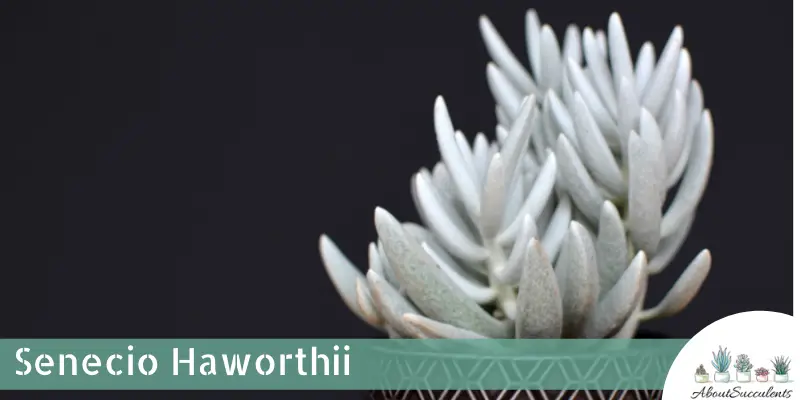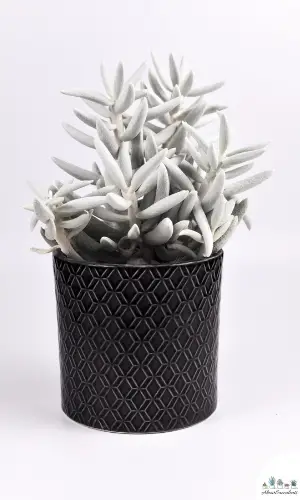
Senecio Haworthii can be a conversation piece in any garden arrangement. The leaves are its eye-catching feature. Approximately 2cm long, the leaves of this succulent shrub are covered by dense, shiny, silver-white colored hairs that make them resemble cocoons.
Thus, the succulent is also known as Cocoon Plant. Another popular alias is Wooly Senecio. The leaves of Cocoon Plant are arranged by its stems and this gives it a thick, columnar appearance.
Senecio Haworthii is native to South Africa and belongs to the Asteraceae family. It produces bright yellow flowers between the winter and summer months.
Categorized as a “dwarf succulent”, Cocoon Plant can grow to a height of 30cm (12”) with a spread of 60cm (24”).
General Information:
Also known as: Cocoon Plant. Wooly Senecio
Plant Family: Asteraceae
Origin: South Africa
Height: 30cm (12”)
Exposure: Direct morning sun for up to 6 hours
Water Needs: Drought-resistant; only water when the soil is completely dry.
Soil Type: Sandy loam mix with added gravel.
Soil pH: 6.0 to 7.0
How to Grow and Care for Senecio Haworthii

The cylindrical, cocoon-like leaves of Senecio Haworthii make it a favorite of many horticulturists. Placed against the backdrop of green-colored succulents, the silver-white, fuzzy hairs of Cocoon Plant make it stand out as an accent piece.
The leaves are not just for show. Their thickness and density are a result of the leaves adapting to changes in temperature that range from -6ºC to 40ºC (42.8ºF to 104ºF).
With a bit of planning, Senecio Haworthii is easy to grow and care for.
Sunlight
As a garden succulent, plant Senecio Haworthii in an area that receives 6 hours of morning sunlight every day.
This type of succulent grows best at a temperature between -4° C – 10° C (-25° F – 50° F). If the temperature in your region drops below -1° C (30° F), it would be best to move Cocoon Plant indoors.
As an indoor succulent, place Senecio Haworthii near a window that receives 3 to 6 hours of morning sunlight.
Watering
Senecio Haworthii is a drought-tolerant succulent and can survive long periods of time without water.
The best method to use for watering is the soak and dry method. Check the topsoil. If it feels dry to the touch, it’s ready for watering.
If you want to be sure, insert a stick an inch into the soil. Remove the stick and if the end feels dry, then go ahead and water until the soil is completely soaked.
Cut back on the watering schedule during the winter months because the soil tends to stay moist longer.
Pot and Soil
The best pot to grow Senecio Haworthii is ceramic or made of terracotta because it allows moisture to escape from the soil.
If the roots are immersed in moist soil for a long period of time, they will rot and develop fungi that can infect the entire plant. It’s also important to make sure the pot has a drain hole with a mesh cover to allow excess water to spill out.
Cocoon Plant is resilient and can thrive in different types of soil but we recommend sandy loam potting mix with gravel added to improve drainage.
How to Propagate Senecio Haworthii
IMultiplying Senecio Haworthii is possible through 2 methods of propagation: Stems and leaf cuttings.
Method 1 – Stem Cuttings Method
Step 1: Choose a healthy stem from the main plant.
Step 2: Cut the stem with a sanitized and sharpened knife or a pair of garden shears.
Step 3: Place the stem in a warm and dry area. Allow it to develop hard calluses in 2 to 3 days.
Step 4: Once the stem has developed calluses, place it on top of potting soil mix.
Step 5: Lightly mist the soil 4 to 5 times a day.
Method 2 – Leaf Cuttings Method
Step 1: Choose a leaf from the stem that has no signs of disease.
Step 2: Perform a clean cut of the leaf from the stem by using a sterilized and sharpened knife or a pair of garden shears. To ensure a successful propagation, make sure no parts of the leaf are on the stem.
Step 3: Place the leaf cuttings in a warm and dry place and allow it to develop hard calluses in 2 to 3 days.
Step 4: Once calluses have formed on the leaf cuttings, place them on top of sandy loam soil and let them take root.
Step 5: Lightly mist the soil 4 to 5 times a day.
Frequently Asked Questions
Is Senecio Haworthii Toxic to Cats and Dogs?
Senecio Haworthii does not appear on the website of the American Society for the Prevention of Cruelty to Animals (ASPCA) list of plants that are toxic to cats and dogs.
This is a partial list and like other varieties, Senecio Haworthii might be harmful to your pets. We recommend keeping pets away from this succulent plant.
If you notice that your pet is unwell after ingesting Cocoon Plant, contact a Veterinarian right away.
Why Is My Senecio Haworthii Dying?
Senecio Haworthii is a low-maintenance succulent plant. If improperly taken care of, Cocoon Plant can develop disease and die. There are 2 causes of your succulent dying: Overwatering and pest infestation.
Overwatering
Overwatering is the number one cause of the death of succulents. Cocoon Plant is drought-tolerant and grows better when given water sparingly.
When you give Senecio Haworthii water while the soil is still moist, the roots will rot and develop infectious fungi that can rapidly spread throughout the plant.
If you see discoloration on the leaves or stems, it’s a sign of infection and these parts must be removed right away with a sterilized and sharpened knife.
You must also remove the plant from the pot to check how much of the roots have rotted. Cut off all of the rotted roots and leave the plant in a warm place to dry out.
Refill a new pot with fresh soil and re-plant Senecio Haworthii.
Pest Infestation
Senecio Haworthii attracts mealybugs that suck it dry of nutritious sap. You can remove the mealybugs by wiping the leaves with 70% isopropyl alcohol or by spraying Cocoon Plant with neem oil.
Does Senecio Haworthii Produce Flowers?
Yes, Senecio Haworthii blooms bright-yellow flowers between the winter and summer months.
Last Updated on June 9, 2022 by Sofia Lara